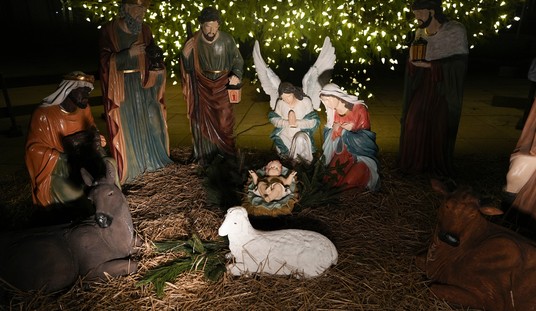It’s a protocol fumble, but is it also a counterpart to Barack Obama’s infamous bow to the Saudi king nine years ago? North Korea’s state-run television channel aired footage of the summit between Kim Jong-un and Donald Trump, complete with what sounds like hyperbolic narration in this clip captured by the BBC. The footage includes a very awkward moment when Trump attempted to shake the hand of a North Korean general, who saluted instead at first. That’s when things got a little … awkward, as one can see at the 55-second mark below (via Twitchy):
North Korean TV has aired its first footage of the #TrumpKimSummit. Look out for the handshake/salute confusion 55 seconds in. pic.twitter.com/JS5yEUprgz
— BBC Monitoring (@BBCMonitoring) June 14, 2018
Where was the protocol officer? The White House has an Office of Protocol precisely to avoid botched optics such as these. The process for working a reception line should have been worked out to the minute detail, allowing Trump to confidently work the process without this kind of ambiguity or misstep. It’s a relatively minor issue in the overall scheme of the summit, but when peace or nuclear war might ride specifically on the impressions left by these exchanges, it behooves the White House and its Office of Protocol to leave nothing to chance. (And perhaps they did prepare Trump for this, and either he or the North Korean general still got confused.)
However, returning a salute even as awkwardly as this isn’t a breach of diplomatic tradition. Some insist on equating it to an earlier incident that did breach American tradition for presidents in meeting foreign potentates:
Remember the controversy when Obama appeared to bow to the Saudi King? https://t.co/tC6fZ8iX0s
— Oliver Darcy (@oliverdarcy) June 14, 2018
Remember all the uproar over when Obama bowed to the Saudi king? https://t.co/TxKgWjJW19
— Hadas Gold (@Hadas_Gold) June 14, 2018
We had plenty to say about that, too, as well as Obama’s bowing to the Japanese emperor after the incident with the Saudi king. In neither case was the bow precipitated by a bow from Obama’s counterpart, although that’s hardly the issue with either. A bow is a show of submission to a foreign monarch or potentate, a show which American presidents and diplomats had refused to make before Obama. When Bill Clinton almost bowed to the same Japanese emperor in 1994, the New York Times let him have it:
It wasn’t a bow, exactly. But Mr. Clinton came close. He inclined his head and shoulders forward, he pressed his hands together. It lasted no longer than a snapshot, but the image on the South Lawn was indelible: an obsequent President, and the Emperor of Japan.
Canadians still bow to England’s Queen; so do Australians. Americans shake hands. If not to stand eye-to-eye with royalty, what else were 1776 and all that about? …
Guests invited to a white-tie state dinner at the White House (a Clinton Administration first) were instructed to address the Emperor as “Your Majesty,” not “Your Highness” or, worse, “King.” And in what one Administration aide called “some emperor thing,” an Army general was cautioned that he should not address the Emperor Akihito at all as he escorted him to the Tomb of the Unknowns at Arlington National Cemetery.
But the “thou need not bow” commandment from the State Department’s protocol office maintained a constancy of more than 200 years. Administration officials scurried to insist that the eager-to-please President had not really done the unthinkable.
In contrast, the proper general protocol for a superior officer is to return a salute given him by a junior. It’s an acknowledgment that his superior rank has been recognized, the opposite of what bowing means. I suspect in this case that the protocol would have been for Trump to wait for the salute to be completed and then offer his hand for shaking; the video seems to indicate that the general expected Trump to do that. The return salute was awkward, avoidable, and a fair point of criticism on its own. However, it by no means was a signal of submission, and to paint it as an equivalent to breaching the “thou need not bow” tradition of American statecraft is simply risible.








Join the conversation as a VIP Member